Laser Cleaning Sculpture
on Lincoln Cathedral's West Front
Jane Cowan
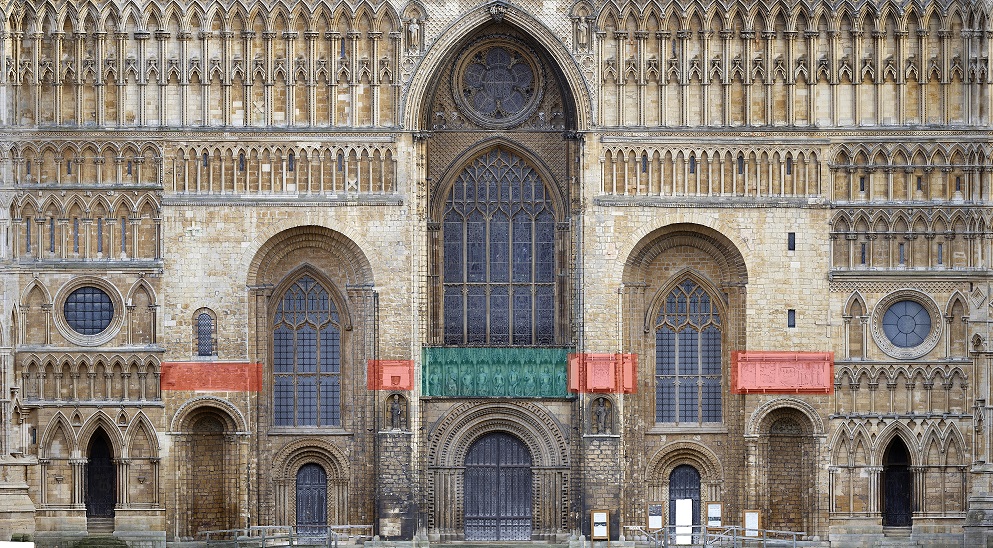
Lincoln Cathedral’s West Front: above, showing the position of the Romanesque frieze highlighted in red and the Gallery of Kings in green.
A major five-year conservation programme on Lincoln Cathedral’s West Front is due for completion in 2022. The process has provided an exciting, once-in-alifetime opportunity to study, clean and conserve some of the country’s finest ecclesiastical carvings.
One of the many challenges has been the large-scale cleaning of sometimes fragile external sculptures, often retaining traces of historic paint. This required the most sensitive of approaches, and with the absence of museum conditions a bespoke multi-faceted cleaning strategy was needed.
For this type of work the primary method of choice has been laser cleaning due to its unequalled controllability and the finish it provides. These advantages, however, have to be balanced with the need to overcome practical site issues, health and safety requirements and the persistent problem of laser cleaning stone where painted decoration survives.
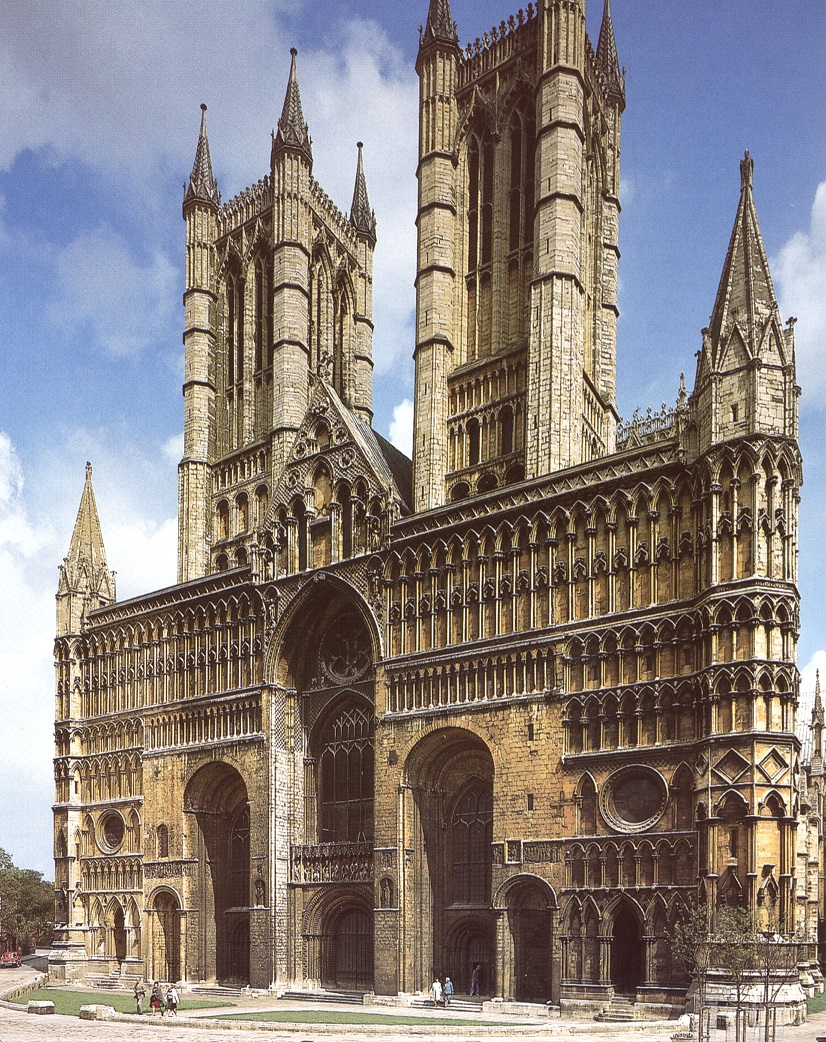 |
|
| The West Front in the 1970s before the frieze sculptures were covered up. |
Lincoln Cathedral
Dominating the town of Lincoln, the cathedral is spectacularly positioned high on the limestone ridge that runs down to the River Witham. On entering Cathedral Close from Castle Square, through the imposing 14th-century Exchequergate Arch, the scale and majesty of the building, in particular the West Front, are awe-inspiring.
Begun in 1072 by Bishop Remigius de Fécamp, a relative of William the Conqueror, the cathedral was heavily remodelled in the 13th century, with later 14th-century additions resulting in a composite style, which, nonetheless, gave rise to one of Europe’s greatest ecclesiastical buildings.
The front of the cathedral comprises a wealth of decorative stone carvings, from the internationally important Romanesque frieze panels and 17 figure sculptures, through to the exceptional detail of the Romanesque door surrounds and fine 13th-century capitals and bosses.
Background to the Heritage Lottery Project
The last major campaign of repairs on the West Front took place in the 1990s. Following this substantial period of work, however, a number of areas still had to be completed.
This included the entire central recess, the 14th-century Gallery of Kings sculptures, the nine southern panels of the Romanesque frieze, and two early 12th-century bishop figures.
In 2017 the National Lottery Heritage Fund (NLHF) awarded the Dean and Chapter a £12.4 million grant to undertake works to the cathedral.
These funds allowed a major restoration and extension project to the former Old Deanery – including a new visitors’ centre – the landscaping of The Dean’s Green, and an intention to complete the conservation of the West Front left unfinished for 40 years.
The initial focal point for the NLHF project was the Romanesque frieze, a series of 18 relief carved panels set into the Norman façade. Located 8m (26 feet) above ground either side of the central portal, the panels depict scenes from the Old and New Testaments.

The Gallery of Kings sculptures, dating from c1380, is a remarkable and often overlooked set of life-sized statues.
The entire Romanesque frieze had been covered with protective boxes in 1982. Although the sculptures in the northern half were uncovered in the 1990s for a conservation programme, finances did not permit extending this to the southern side, which remained boxed in.
Between the northern and southern frieze panels is the Gallery of Kings, inserted somewhat indiscriminately into the central portico so that it obscures the top of the arch.
These sculptures are an extraordinary example of late 14th century carving, and consist of an unusually homogeneous group of 11 life-sized statues of bearded kings.
Each king sits beneath an intricately carved vaulted canopy, and they remained largely undamaged and unrestored. Much of the focus of the cathedral’s conservation department over the last three years has been on cleaning and conserving these two groups of sculptures.
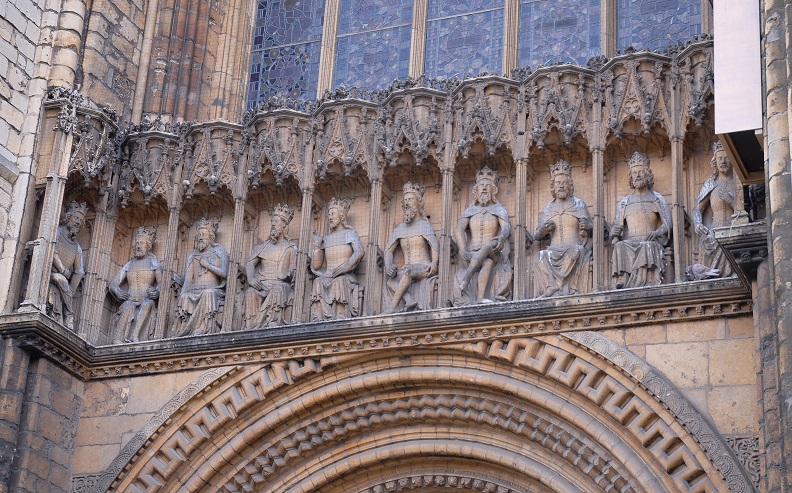
The Gallery of Kings sculptures, dating from c1380, is a remarkable and often overlooked set of life-sized statues.
Examination and Condition Assessment
Following the erection of scaffolding at the West Front in 2018, a full assessment and conservation report was undertaken on each sculpture prior to any work commencing.
The Gallery of Kings was found to be in good overall condition, a testament to the superior quality of the Lincoln Redbed limestone used, combined with a sheltered location and an absence of iconoclasm or heavy-handed restoration.
Dirt levels were moderate to light (it is likely they had been scrubbed at least twice during the 20th century) with generally 1–3mm-thick, black sulphation crusts in sheltered areas, crusts of pigeon guano, and tenacious grey dust on the upper surfaces.
The condition of the Romanesque frieze, however, was found to be more variable, with some of the panels showing severe structural distress. The frieze was carved from an Ancaster type stone, which is an oöidal limestone.
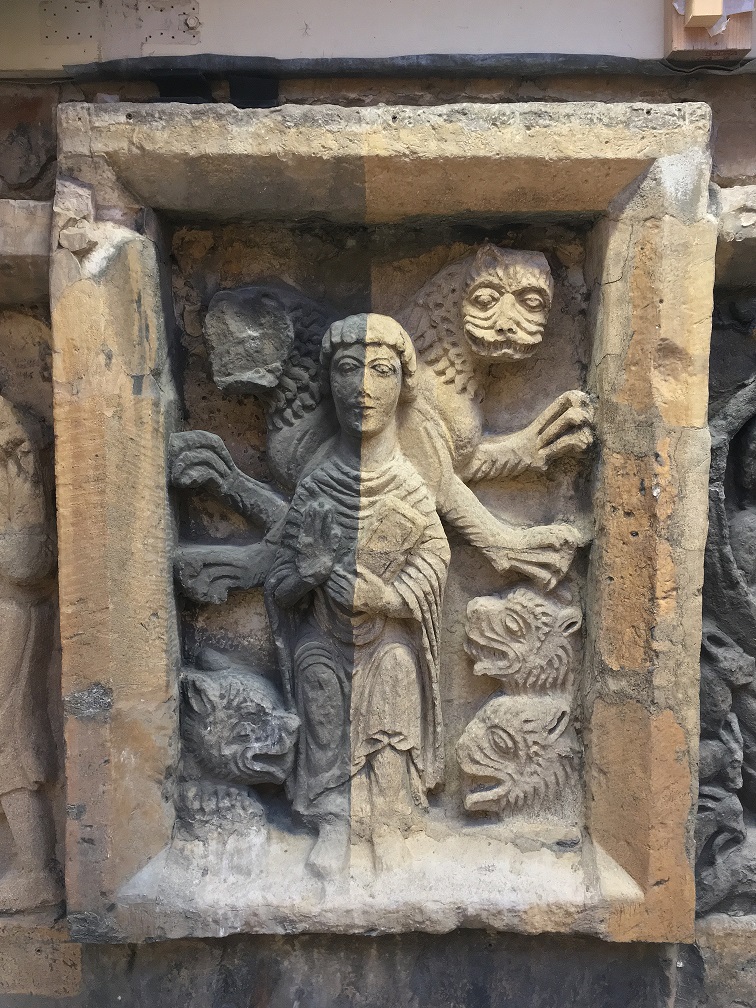 |
|
| Cleaning work in progress on the Daniel in the den of lions panel of the Romanesque frieze, with the right-hand side laser-cleaned. |
Both Ancaster and Lincoln Redbed limestone are classed as Lincolnshire limestones but they have different visual appearances and qualities.
In the mid-20th century Lincoln’s air pollution levels were still high due to local industry and the number of coal-fired power stations in the area.
The surface of the frieze was often obscured by heavy black sulphation, up to 6mm thick, that had accumulated since they were cleaned in 1961.
Analysis of the dirt’s composition found it to be mainly gypsum (calcium sulphate), calcite and fly-ash particles (a coal combustion product). Oil-based spherical globules and other planar organic growths were also seen under 400x magnification. (Pouli, 2000, pp.63–66).
Historic Architectural Paint
It is widely known that the majority of medieval buildings would have appeared quite differently then to how we see them now, and were finished with coatings of limewash or sometimes colourful paintwork (polychromy).
Research over the last 30 years has shown us that the West Front of Lincoln Cathedral would have had a rich architectural polychromy, much of which was removed, or covered over with ochre limewash in the 19th and 20th centuries.
The remnants of small fragments of historic paint found across the West Front sculptures are precious, and there is a great risk of losing them when cleaning is being undertaken.
Before starting our conservation programme, therefore, every care had to be taken to ensure that these remnants were recorded and preserved.
Following initial visual examination and recording, detailed investigations on both the Gallery of Kings and the Romanesque frieze included a first phase of polychromy sampling and analysis by wall paintings conservator Eddie Sinclair and paint analyst Catherine Hassall, with a second phase of recording undertaken after cleaning.
A combination of careful polychromy mapping by the in-house team, followed by investigation by the paint specialists, provided preliminary documentation for locating and identifying medieval paint during the cleaning process.
The exciting results showed that extensive pockets of vibrant polychromy were found to have survived. The phase one survey of the Gallery of Kings identified a distinctive ground layer of red and yellow oxides, with exotic pigments such as azurite and vermillion also found.
Phase two polychromy recording of the southern Romanesque frieze panels revealed leadwhite ground, red, yellow and ‘golden’ ochre, copper blue/green, vermillion, and azurite, as well as a tantalising glimpse of sophisticated glazes.
It was important for the conservators to familiarise themselves with the scheme before they started to clean, as the dirty and degraded nature of much of the paint required great vigilance and sensitivity during the process.
Cleaning Issues
Cleaning trials began on the Romanesque frieze in May 2018. One unique feature of Lincoln limestone is the beautiful, golden ochre patina that it naturally develops over many years in sheltered areas.
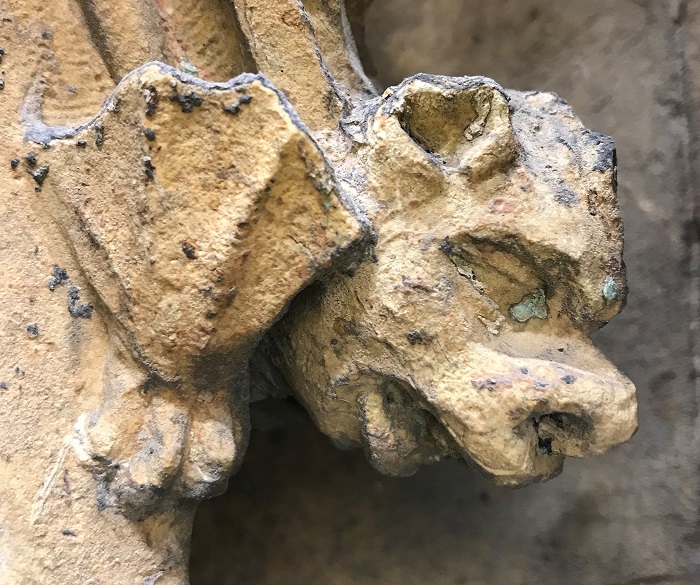 |
|
| Detail of a cleaned carving from the Gallery of Kings canopy (approx 30mm (1.18 inches) in length) with remains of green polychromy and white ground around the eye |
Fragile and easily damaged to reveal the tell-tale creamy stone beneath, this acts as something of a ‘canary’ when cleaning – its loss indicating that the operative has gone too far.
Micro air-abrasion (MAA) using aluminium oxide had been the technology of choice when cleaning nine of the ten northern Romanesque frieze panels in 1987–90. This widely used technique is capable of giving a satisfactory clean over fragile surfaces and polychromy.
Subsequent cleaning in 1997 was then undertaken using a combination of laser and, where polychromy was identified, MAA. When used exceptionally carefully and sensitively, MAA can give a visually satisfactory result.
However, subsequent scanning electron microscopy (SEM) images on samples of Lincoln stone clearly showed damage caused at microscopic level by the abrasive particles, which we were keen to avoid.
In addition, when trialling cleaning techniques on the frieze and Gallery of Kings in 2018, the same visual results could not be replicated, partly because we were unable to source a satisfactorily sensitive micro air-abrader, and partly because of a necessary change of aggregate from aluminium oxide to aluminium silicate due to health concerns over the former.
Laser Cleaning
In the last 30 years or so, laser cleaners have come to play a greater role in the restoration of our building heritage. Lincoln Cathedral has a long association with laser cleaning, initially working with leading figures John Larson and Professor David Emmony in the 1990s.
John Larson, formerly Head of Sculpture Conservation at the Victoria and Albert Museum and National Museums and Galleries Mersyside, began investigating the idea of using a laser for sculpture cleaning in the mid-1980s.
David Emmony headed up laser research at Loughborough University and collaborated with research at Lincoln Cathedral. This collaboration led to the successful early use of on-site laser cleaning in the UK with the cleaning of a fragment of the Romanesque frieze panel in 1997.
As a consequence of this successful project, in 2012 Lincoln Cathedral purchased its own laser for future cleaning projects. The basic principle of laser cleaning is that the dark layer of dirt absorbs the radiation (or energy), while the lighter surface beneath reflects most of that energy away.
The Q-switched Nd:YAG laser, most commonly used for stone, works by causing the top layer of dirt to be selectively thermally vapourised, or ablated, from the object’s surface – using what is essentially a very short pulse of heat – an action that occurs so swiftly that the dirt is removed before there is significant heating of the stone substrate.
Cross section images show one of the laser’s great advantages is its ability to retain the gypsum-rich patina of the stone located just beneath the crust of dark particulates. It is a precise and very controllable technique.
However, the damaging effect of laser radiation on a number of common pigments is well known. Vermillion and lead-based pigments are especially sensitive, with vermillion becoming permanently blackened.
Iron-based pigments tend to be moderately sensitive; while copperbased pigments are generally more stable, although care is still needed.
The binding medium in any of these may also play a role. As a result, where polychromy is suspected on a sculpture, lasers must be used with extreme care, and the more information known about the pigments beforehand the better.
Working Practices
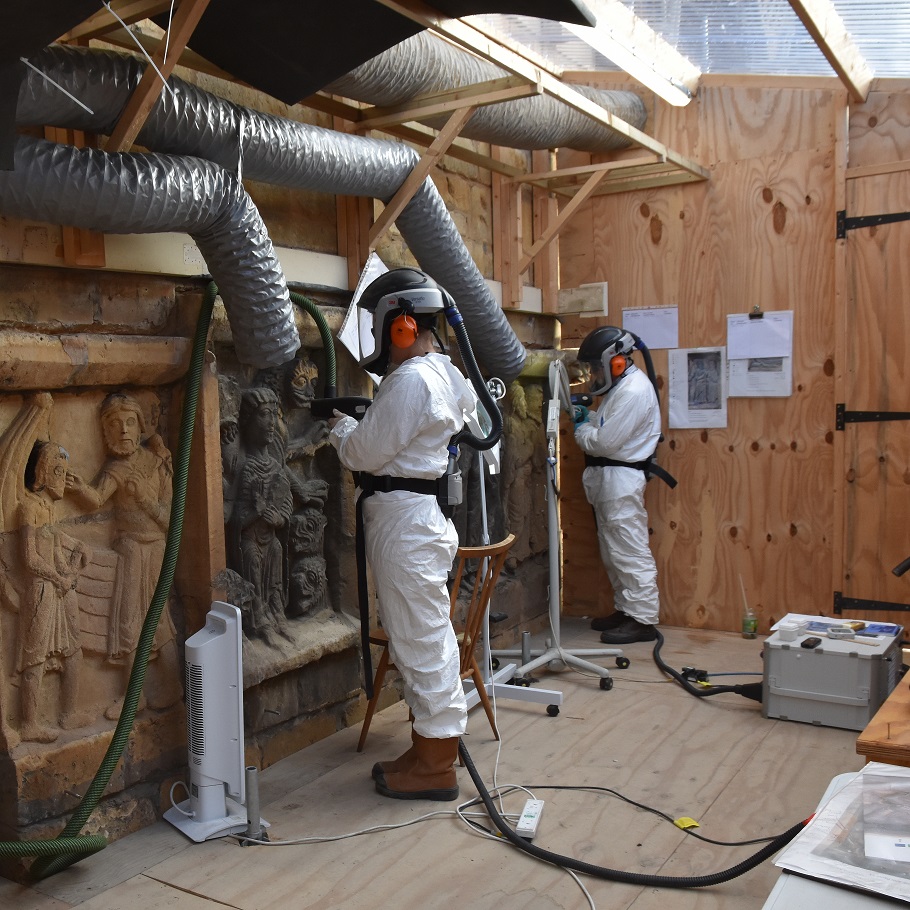
Conservators in the process of cleaning the Romanesque frieze in the purpose-built shed; one of the lasers can be seen on the floor in the right of the picture.
Following the erection of scaffolding in 2018, a large shed was constructed with 240V electrics, a clear polycarbonate ceiling and good lighting, providing optimal working conditions for the conservators in all weather conditions.
Built with the potential of laser cleaning in mind, the workshops were tightly constructed, and contained an internal locking system to prevent inadvertent access.
It should be noted that there are a number of health and safety issues to consider when cleaning with an infrared Q-switched Nd:YAG laser, with potential for damage to the eyes and skin, through inhalation, or as a fire hazard, and training is essential for all operatives to fully understand the risks.
Our conservators therefore worked wearing full Tyvek suits and gloves, with 3M Versaflo masks and laser goggles. Local extractors as well as a large overhead extraction system ensured good airflow and ventilation.
Before cleaning, polychromy mapping was undertaken on Adobe Illustrator by using a digital overlay on a photograph to indicate all the areas of coatings and paint we found (illustrated on theprevious page).
This mapping, as well as providing a record of the sculpture as found, was a working tool for the conservators, highlighting areas where extreme caution or alternative methods of cleaning were to be used.
Following cleaning tests and trials the decision to use the laser was a straightforward one, but we were left with the issue of how to approach cleaning the areas of polychromy vulnerable to potential laser damage.
Our solution came in two forms. Firstly, the use of a polymer gel applied to laser-sensitive areas, which gave full control when removing light dirt.
This comprised a polymer-based poultice used to soften and remove thin sulphation layers (carbopol and triethanolamine base with 1–2% tri-ammonium citrate for the upper dirt layers) applied with variable dwell times, and removed using de-ionised water.
Secondly, where dirt was more tenacious, our ‘back-up’ system was an IBIX 9 Eco-Blaster dry-air abrasion unit, with a 1mm pencil nozzle using fine garnet powder, which gave a sufficiently sensitive result in challenging areas when used between 0.5–1 bar pressure.
Cleaning began with the removal of any loose debris and build-up of guano deposits: thick black sulphation crusts were removed using fine riffling files to save time.
The area of carving to be cleaned was checked for any known signs of polychromy, and if found to be clear, testing was undertaken to fine tune the laser parameters.
Following this a first pass of the laser was undertaken. If the dirt was found to be stubborn, a light misting of water was used to help increase absorption of laser energy by the dirt, potentially enhancing the cleaning effect and speed.
Although highly discriminating, the term ‘self-limiting’ for laser cleaning can be misleading – if an object absorbs energy, damage is possible.
The lowest energy fluence (or strength) was used, usually between 100–115 (the full range being 90–210), and a pulse rate of 15 per second (out of 1–30).
In terms of polychromy, the fluence level needed to remove the dirt layers is important – the lower the fluence, the less likely there is to be inadvertent discolouration or damage to the pigments.
If an area of polychromy or an unidentified coating was observed or suspected, laser cleaning was avoided. If required, this area was then revisited with gels for more controlled cleaning, or, where necessary, the IBIX.
On a practical note, the model used was Lynton Laser’s Compact Phoenix, which is roughly the size of an office A4 printer and can be carried onto site by two people if required.
Due to its temperature sensitivity – the water cooling system means that allowing it to stand in freezing weather would be highly inadvisable – it sometimes required wrapping up or bringing down from site in very cold weather. Luckily, it has proved suitably robust in being regularly man-handled.
The speed of laser cleaning is highly variable dependant on the thickness and type of dirt and the location of the sculpture. In order to avoid piercing the rich ochre patina or producing a ‘leopard’ print effect with high spots of black dirt remaining, the process required constant vigilance and sensitivity.
Cleaning of the nine Romanesque frieze panels at low-moderate strength and speed took nine months in total, with generally two conservators working side-by-side (a second machine was hired due to time pressures).
The Gallery of Kings is in its final stages at the time of writing and will have taken 10 months with one conservator. As an aside, on-site testing showed that this rate was considerably faster than comparable MAA/IBIX cleaning.
The Result
The effective removal of decades of dirt gave us fascinating glimpses of the sculptures’ original polychromed appearance. It revealed small human details such as pencilled graffiti from those who went before us, and previously unseen details such as 18th-century resin repairs (still holding up!).
The aim of our finished clean on the West Front sculptures was to remove 90–95 per cent of soiling rather than 100 per cent, giving us the opportunity to ‘pull back’ when we felt that areas were vulnerable, while still achieving an overall harmonious appearance.
Cleaning on any conservation project can be a multifaceted and complex process; rarely does one-size fit all. On-site cleaning with a Q-switched Nd:YAG portable laser is generally a superior cleaning method for stone, but can be expensive to hire or purchase and maintain.
It presents some major practical obstacles, requires safe working practices and ultimately, as with all methods, the quality of the end result depends on the skill and sensitivity of a trained and experienced practitioner.
However, at Lincoln Cathedral the laser successfully provided the high level of delicacy and control needed for this project, especially when integrated with other techniques such as gel poultices, selective micro air-abrading and polychromy mapping, giving minimal damage and optimum results.



